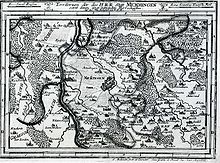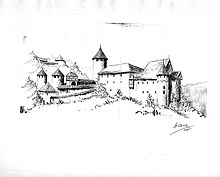Rafting on the Iller
The rafting on the Iller or Iller rafting was a trade of transport on the Iller with the main destination Ulm . Goods of various kinds were transported , mainly wood . It was first mentioned in documents in 1397, and the last raft trip took place in 1918.
history
The Iller, which arises in Oberstdorf from the confluence of the Breitach, Stillach and Trettach and flows into the Danube after 147 kilometers near Ulm , is the first flowable tributary of the Danube. Extensive barrows in the Illertal on both sides of the river, including in what is now the city of Memmingen in the area between Volkratshofen and Brunnen , document an early settlement of the area in which the later rafting places were. At the time of the Roman Empire , the troops of Rome and their merchants opened up the part of their province, later called Raetia , with the help of boats on the Iller up to its confluence with the Danube.
There is historical evidence of rafting on the Iller in a document from the Holy Roman Empire from 1397. In that year, imperial customs privileges relating to rafting between the bridges in Kempten and Kellmünz were given to the brothers von Königsegg-Aulendorf as masters of the castle awarded by Marstetten . This castle, halfway between the above-mentioned places, was then plundered and destroyed during the German Peasants' War in 1525 by dissatisfied Waldburg serfs from the area. On July 29, 1566, Johann Jacob, Baron von Königsegg-Aulendorf, sold the Marstetten estate with the ban on blood and bridge toll between Ferthofen and Egelsee to Karl I, Count von Hohenzollern , the then guardian of the Waldburg noble house, with the consent of the then Prince Abbot of Kempten , Georg von Gravenegg-Burchberg, for 100,000 guilders . The Egelsee customs fell to the city of Memmingen in 1578. On September 25, 1595 Froben von Waldburg-Zeil became the owner of Marstetten and Aichstetten. In 1675 the rule fell to the Wurzach line of the Waldburg nobility.
An engraving from 1590 with the title Memmingen und Umgebung around 1590 shows the Iller between the bridges of Ferthofen and Egelsee , two manned rafts and a few boats. Above the raft are Aitrach , Marstetten Castle , Mooshausen, Kronwinkel, Tannheim and Arlach, and the imperial city of Memmingen on the other side of the river. This area was not only part of the secular territories of the House of Waldburg and the city of Memmingen. Other suppliers of the logs and the goods that were transported down the iller by the rafting company and that can be seen on the map of the Memmingen territory with bordering territories from 1717 were also the bordering spiritual territories : the Reichsabbey Rot an der Rot , the Reichsabbey Ochsenhausen with official seat Tannheim and the Buxheim Reich Charterhouse .
In 1806, in the course of secularization and the associated dissolution of the spiritual territories, the area was roughly divided into two and crown fiefs of the kingdoms of Württemberg and Bavaria were formed. The Württemberg part found itself in the Oberamt Leutkirch . In the descriptions of the individual localities of the Leutkirch Regional Office from 1843, August Friedrich Pauly , who was never able to complete his work on the Real Encyclopedia of Classical Antiquities in alphabetical order , repeatedly refers to rafting on the Iller.
Aitrach lies at the point where the Aitrach joins the Iller. There is lively activity in the timber trade and rafting, and an important sawmill. A beautiful new, covered bridge leads over the Aitrach.
In the course of industrialization , the Iller was no longer continuously passable: Due to the construction of weirs and hydroelectric power stations on the river, rafting increasingly lost its importance. With the construction of the Neu-Ulm – Kempten railway line through the city of Memmingen, traffic was shifted to the railroad tracks.
Today is a big part of the forestry used forest from which the main manor of raft transport, the roundwood came, owned by the former noble houses Waldburg-Zeil , of Schaesberg , von Finck , also is privately owned forests , churches forests and owned by the city of Memmingen . The rafters' pick-up places are in the districts of Biberach , Ravensburg , Unterallgäu and in the city of Memmingen .
The end of the 19th century also marked the end of rafting. Railway lines along the Iller guaranteed faster, safer and more regular transport of goods. In 1909 the Kingdom of Bavaria and the Kingdom of Württemberg decided to build several run-of-river power stations and the Illerkanal from Mooshausen to Ulm. The construction of the Illerkanal resulted in a falling water level in the river. All run-of-river power plants operated by EnBW and Lechwerke are still in operation today along the Iller. Raftsmen became tolerated but annoying troublemakers. In 1918 only two raft transports to Ulm were recorded; they were the last.
Travel time, goods and goods
The journey on a raft from Aitrach to Ulm was six hours at normal water level and three hours at high water . Back you could cover the approximately sixty kilometers from Ulm to Aitrach in twelve hours on foot. When he arrived in Ulm, the raftsman started up with the motto catch, catch up with the Danube lands. At peak times in summer, 30-40 rafts landed in Ulm every day. There were essentially three unloading stations, called "raft lands": the brick, goose gate and stove bridge gate. The unloaded raft was then pulled several hundred meters upstream again and dismantled in the so-called grinding hole. According to records, 42,000 solid cubic meters of wood reached the city of Ulm in 1850 . This amount corresponds to around 1,400 truckloads loaded with logs. But not only wood and its by-products were transported on the rafts, but also:
| Were | ||
|---|---|---|
| cheese | Stones | Grain |
| Wine | Fires | salt |
| canvas | Animals of all kinds |
| Wood | |
|---|---|
| Round wood | Lumber |
| firewood | Charcoal |
The Italian wine over the salt road to Kempten. Baden and French wine to Ferthofen and from there with rafts to Ulm and further.
Rafting
Not only raft owners and raftsmen lived from the trade, but also forest owners, foresters, woodcutters, wagoners, timber merchants, sawmill owners, trift masters, rope makers, saddlers, cobblers and blacksmiths . The equipment of the Iller rafters, who mostly came from the petty bourgeois rural milieu, or of the raftsmen in general, included a massive ax, drill, ropes and birch nails. These utensils were packed in a waterproof leather bag. Hip-high leather boots protected the raftsmen when working in the water.
Pick-up places:
- Below Illerbeuren on today's border
- at the house of Konstantin Gallasch
- at the Lochbauer in the rank
- left the Iller at Ignaz Frommeld
- left the Iller with Philipp Bärtle
Pick-up places within Aitrach:
- under the Deckten Bruck (between Aitrach and Marstetten)
- at the torrent
When on the third Sunday of Lent, formerly called Oculi , the pastor opened the Introit with the Oculi mei semper ad Dominum and the Gospel of the casting out of the devil was read, the raftsman also knew that the time had come to resume work after a long winter. Bärtle reports in his book that between 1837 and 1883 seven raftsmen from the Aitrach area drowned while practicing their profession. He reports on an accident near Oberkirchberg in 1880 , in which three raftsmen had an accident and died in a single day. There were also distinct rafting hostels along the Iller, such as the Rößle in Aitrach or the Hirsch in Mooshausen.
There were two types of rafts:
- Badrischen (so called small raft)
- Flaud (actual raft)
During the Turkish Wars, a regiment of imperial troops with a strength of around 4,000 men was assembled from the Iller area and sent to Ulm and from there to Vienna. How many of them came back alive is not known. After the liberation, a wave of emigrants from Upper Swabia to Hungary, liberated from the Turks, began.
At times, Flößer lived in every second house in Aitrach; Raft owners and raftsmen came from families:
- Bärtle
- Gmeinder
- Gallasch
- Graf (Fluhmühle)
Even today, the rafting is reflected in the costumes of the fools' guilds. The Elferrat the Narrenzunft Aitrach exchanged his 1985 based on the Rhenish Carnival costumes by a costume reminiscent of the clothing of the traditional Iller rafter. The Elferrat's moving van is always modeled on a raft.
In 2010 a work of art dedicated to the Iller rafting was inaugurated within a roundabout on the road from Aitrach in the direction of Ferthofen.
See also
literature
- Bärtle Josef: The Iller rafting. A contribution to the local history and folklore of the Illertal. Illertissen 1932
Web links
- The Iller rafting in Aitrach , by Peter Roth, Im Oberland 2008 issue 1 (PDF; 1.4 MB) from the Ravensburg District Office website
Individual evidence
- ↑ Official Journal of Aitrach, 24-10 (PDF document) ( Memento of March 13, 2012 in the Internet Archive )


